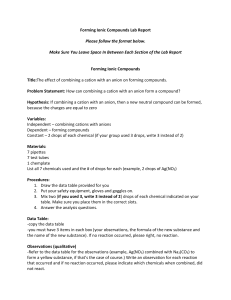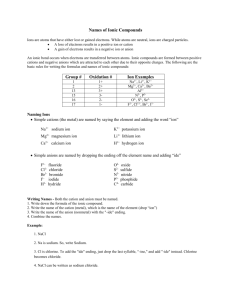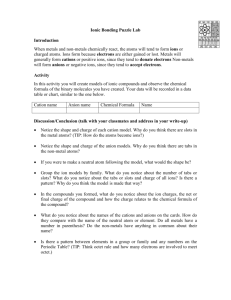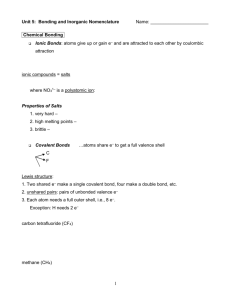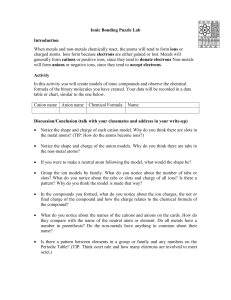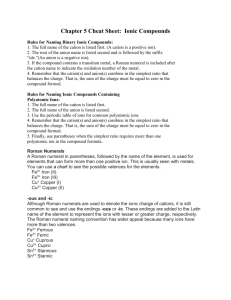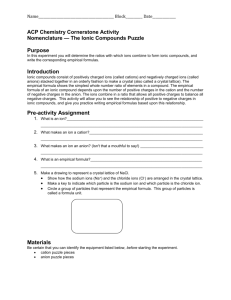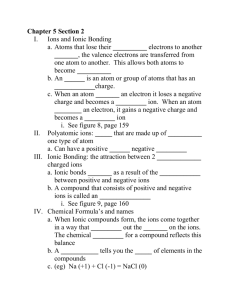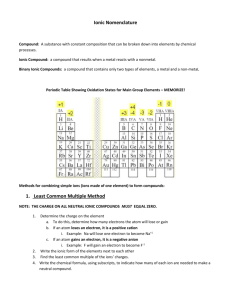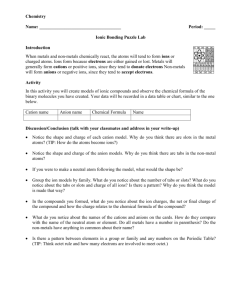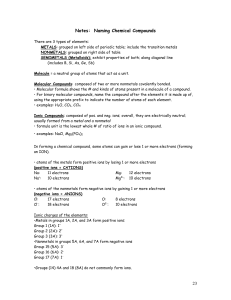Ionic Bonding & NOMENCLATURE
advertisement
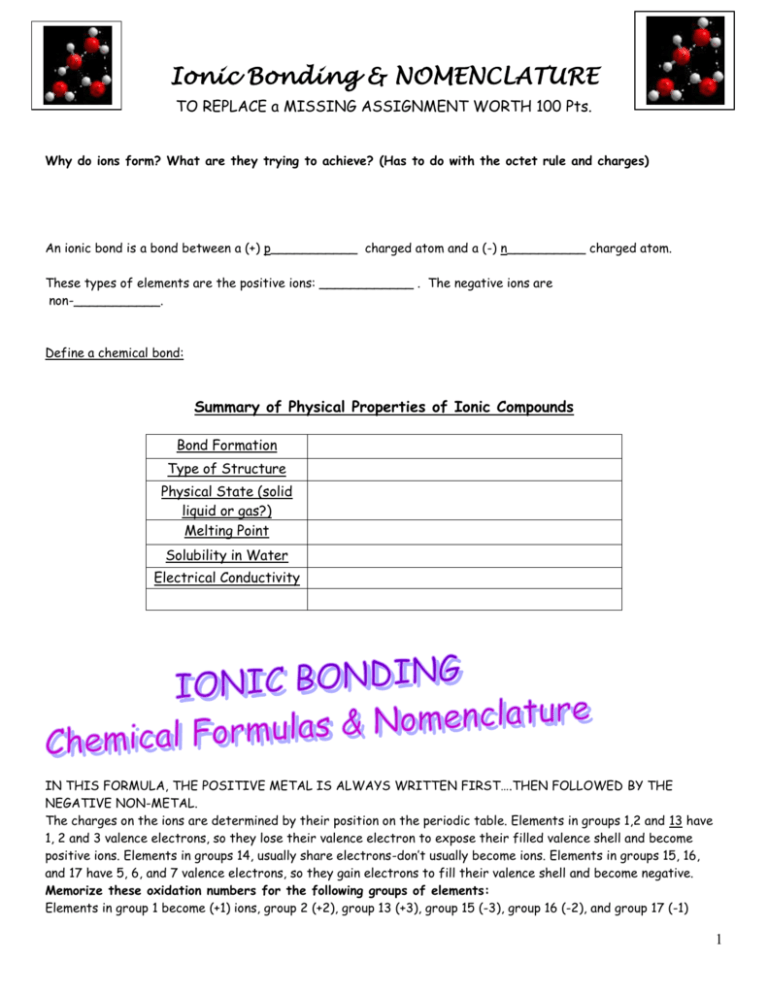
Ionic Bonding & NOMENCLATURE TO REPLACE a MISSING ASSIGNMENT WORTH 100 Pts. Why do ions form? What are they trying to achieve? (Has to do with the octet rule and charges) An ionic bond is a bond between a (+) p___________ charged atom and a (-) n__________ charged atom. These types of elements are the positive ions: ____________ . The negative ions are non-___________. Define a chemical bond: Summary of Physical Properties of Ionic Compounds Bond Formation Type of Structure Physical State (solid liquid or gas?) Melting Point Solubility in Water Electrical Conductivity IN THIS FORMULA, THE POSITIVE METAL IS ALWAYS WRITTEN FIRST….THEN FOLLOWED BY THE NEGATIVE NON-METAL. The charges on the ions are determined by their position on the periodic table. Elements in groups 1,2 and 13 have 1, 2 and 3 valence electrons, so they lose their valence electron to expose their filled valence shell and become positive ions. Elements in groups 14, usually share electrons-don’t usually become ions. Elements in groups 15, 16, and 17 have 5, 6, and 7 valence electrons, so they gain electrons to fill their valence shell and become negative. Memorize these oxidation numbers for the following groups of elements: Elements in group 1 become (+1) ions, group 2 (+2), group 13 (+3), group 15 (-3), group 16 (-2), and group 17 (-1) 1 Remember, group 18 is the noble gases, they have a filled valence shell, so they don’t become ions. When ionic compounds are formed, they must form a compound that is n . In other words: cations and anions must be combined such that the total positive charges equal the total negative charges. Look up the family names (groups) on the periodic table and name the charges of the elements in that group. Link to a periodic table: http://www.ptable.com/ FAMILIES & CHARGES Alkali metals Alkaline earth Boron family Carbon family Nitrogen family Oxygen family Halogens Noble gases + or negative-they share No charge, don’t become ions Naming Ions Examples: Metal (Cation) keeps the name of the metal K - Potassium Ca- Sr- Nonmetal (Anion) Br - Bromide Cl- O- Oxide F- N- S- -ide ending tells you that the anion came from a single element from the periodic table Transition elements (2nd class ions) can sometimes form cations with more than one charge. These cations are named by including their charge as a Roman numeral in parentheses. SO THE ROMAN NUMERAL TELLS YOU THE CHARGE OF THE METAL !!!! The Roman Numerals are: I II III IV V VI VII Cu+ is the Copper (I) ion, while Cu2+ is the Copper (II) ion. VIII IX X Pb(II) = ________ Co (III) = ________ LET’S PRACTICE!!! Write the formulas for the ionic compounds formed between the following elements: REMEMBER YOU NEED TO BALANCE THE CHARGES! 1) First Step, determine the charge of each element- look at where it is in the periodic table and find the oxidation number (page 1 of this sheet helps you with that) 2) Write that charge above the element so you know how much the charge is 2 3) Make sure you have the same number of positive charges as negative. Criss Cross Rule When determining what ionic compound will be formed, you can use this rule to help you figure out the ratio of one element to another. Each compound formed should result in a 0 charge. Take the charge of the cation (the positive ion), and use that number as the subscript of your anion (the negative ion). Take the charge of the anion and use that number as the subscript for your cation. The subscript means how many of those atoms are in the formula. Ca3N2 has 3 Ca atoms and 2 N atoms. Examples You Try it!!!! Al +3 Cl- Ca +2 N-3 Formula is AlCl3 This Formula is Ca3 N2 We don’t write the 1 as a subscript, it is understood that there is one aluminum Charges are balanced! 3 x +2(Ca) = +6 2 x -3(Na) = -6 IONS 1. Al +3 S -2 Al +3 O-2 ________________ Assembling Ionic Compounds: FORMULA 2. Ba +2 N -3 3. Li +1 Br -1 4. Na +1 O -2 5. Ca +2 Cl 6. K +1 -1 P -3 7. Zn +2 Cl -1 Since we are talking about ionic compounds (METAL + NONMETAL), let’s start with that. ~*RULES FOR NAMING IONIC COMPOUNDS*~ 1. IDENTIFY THE CATION AND ANION. Most ionic compounds (and any I would ever give on a test) have two word names. The first word in the name is the name of the cation, and the second word is the name of the anion. There is no exception to this rule. 2. NAME THE CATION. The cation is the easy part. Just find it on the periodic table and there you go UNLESS it is one of the transition elements….in that case it will be specified by a roman numeral I, II, III, etc. if it is positive 1, 2, 3 3, etc. 3. NAME THE ANION. How about anions? If the anion is only one type of atom, then the name of the anion is the same as the name of the element EXCEPT the end of the element name is taken off and "-ide" is added to the end. a. BUT, sometimes it will seem like there is more than one element there….So the question is: does the anion have more than one atom? If the anion has more than one atom, like SO4 then we'd say that it's a "polyatomic ion", meaning that the anion has more than one atom. It works like one ion, so it has to stay together in a compound to be that ion and you don’t change the name such as Sulfate, or Nitrate. If you need more than one in the compound, you need to write a subscript outside parentheses, such as Ca(NO 2)2 You will be given a table with the polyatomic ions, so you don’t need to memorize them. None of the examples below will have polyatomic ions. Ionic Compound Naming Practice: Formula to Name Formula Name Potassium Oxide K 2O CaCl2 K 3P Zinc Chloride ZnCl2 CaO Al2O3 Ionic Compound Naming Practice: Name to Formula Name Formula Example: Potassium Chloride Example: KCl Calcium Bromide Lithium Oxide 4
